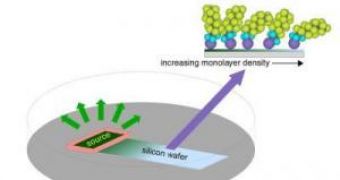Self-assembly is the fundamental principle which generates a structural organization on all scales from molecules to galaxies. It is defined as reversible processes in which pre-existing parts or disordered components of a preexisting system form structures of patterns.
Researchers from the National Institute of Standards and Technology (NIST) and North Carolina State University (NCSU) made new observations of the growth of a layer of molecules that self-assemble to gradually cover the surface of a small silicon rectangle.
This new study provides valuable information into how self-propagating self-assembly wave fronts develop. Examples of self-assembling system include weather patterns, solar systems, histogenesis and self-assembled monolayers. The most well-studied subfield of self-assembly is molecular self-assembly, but in the recent years it has been demonstrated that self-assembly is possible with micro and millimeter-scale structures lying in the interface between two liquids.
The fact that an open system increases in complexity without being guided or managed by an outside source is very important in studying the properties of some materials, such as rocks and cement. The system studied by the NIST/NCSU team was a spontaneous assembly of organosilane molecules into a monolayer film on an oxidized silicon surface.
The experiment placed a number of carbon-silicon-based molecules along one edge of a treated silicon wafer. Under specific conditions, the organosilane molecules organized themselves into a well-ordered layer, spontaneously, to create a thin layer on the silicon, that starts from the edge of the wafer and advances at a constant speed.
What's really new about this experiment is the fact that, contrary to classical theories, the results show that the interface of the growing wave at the front broadened in time, for a longer period, which could lead to new applications in construction materials, but also in silicon-based electronic equipment.

 14 DAY TRIAL //
14 DAY TRIAL //